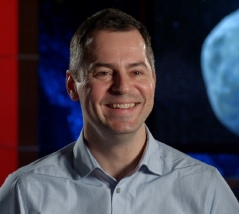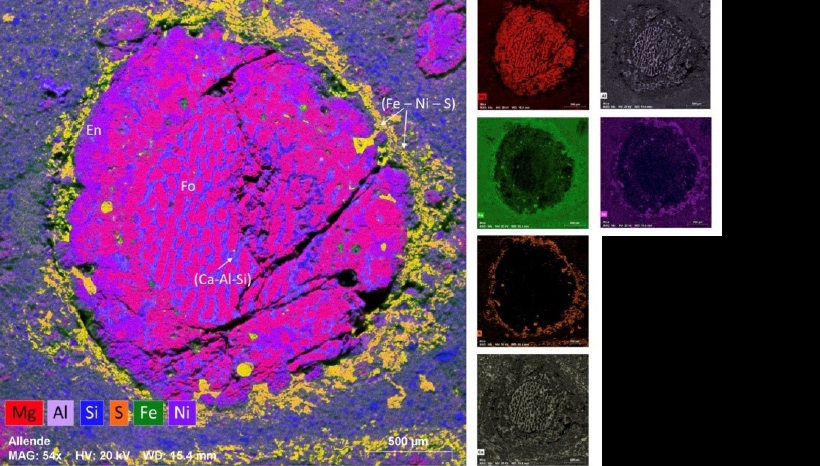As of this week, OSIRIS-REx has travelled over 1.5 billion km since its launch in Sept. 2016. It is currently 47.7 million km from Earth and has a little over .5 billion km left to travel until it reaches the asteroid Bennu.

"THE 60 GRAMS OF PRIMITIVE MATERIAL WE COLLECT FROM BENNU CAN GIVE US CHEMICAL INDICATORS OF LIFE ON OTHER WORLDS”
-Dr. Daly, who leads the science contribution of Canada’s OSIRIS-REx Laser Altimeter (OLA) to the NASA New Frontiers mission that was launched in September 2016 toward asteroid 101955 Bennu - the first B-type asteroid to be visited by a spacecraft.
Professor Michael Daly is the York University Research Chair in Planetary Science. He recently received the honor from the International Astronomical Union of having the asteroid 1999 UW25 renamed as (129973) Michaeldaly. He was also the Canadian Aeronautics and Space Institute’s 2016 W. Rupert Turnbull lecturer who is selected for his/her association with some significant achievement in the scientific or engineering fields of aeronautics, space-associated technologies or their application. This honor recognized Dr. Daly’s contribution to Canadian planetary science mission contributions.
Dr. Daly is currently leading the science contribution of Canada’s OSIRIS-REx Laser Altimeter (OLA) to the NASA New Frontiers mission that was launched in September 2016 toward asteroid 101955 Bennu — the first B-type asteroid to be visited by a spacecraft. A scanning laser altimeter, the OLA instrument will measure the range between the OSIRISREx spacecraft and the surface of Bennu, to produce digital terrain maps of unprecedented spatial scales for a planetary mission. He also works in the area of deep-UV Raman spectroscopy as well as time-resolved laserinduced fluorescence. He is the PI for a new $3.5M Canadian planetary science laboratory focused on the simulation and understanding of planetary surface processes as well as developing instruments and improving analysis techniques for planetary science in-situ investigations. Initial investigations will focus on Mars, asteroids and comets.
He is also the Undergraduate Program Director for York’s unique Space Engineering and Space Science Programs and has been the acting director for the Centre for Research in Earth and Space Science. Prior to joining York University, he initiated and led the engineering of Canada’s first instruments to operate on Mars. These were a two-wavelength atmospheric lidar that observed snowfall on Mars as well as a temperature and pressure measurement instrument. Dr. Daly has also been the engineering lead for a variety of space-flight cameras including the design of the cameras in the DEXTRE robot’s end-effectors aboard the International Space Station. He was awarded a Tier 2 York Research Chair in Planetary Science which enabled his participation in NASA’s OSIRIS-REx mission to the near-Earth asteroid Bennu and the return of Canada’s first sample of material from another solar system.
60 Grams from Asteroid Bennu May Reveal the History of our Solar System
The asteroid Bennu. OSIRIS-REx — the firstever sampling mission by NASA to the distant asteroid Bennu — was successfully launched into space on Sept. 8, 2016 from Cape Canaveral Air Force Station in Florida. The mission will revolutionize our understanding of asteroids and the origins of the universe. Bennu, which is about 500 meters in diameter, is of particular interest because it is one of the most potentially hazardous asteroids presently identified, with a small chance of hitting Earth in the 22nd century. In Oct. 2018, a 60 gram sample will be collected from Bennu and returned to Earth on Sept. 24, 2023. The sample collection, a five-second sampling contact is challenging, but this small sample can tell us about the formation of our solar system. “Bennu will help us understand what organic components might be present on the asteroid,” said Professor Mike Daly, who is leading the science contribution of Canada’s OSIRIS-REx Laser Altimeter (OLA) for this mission. “Bringing a sample back enables us to use instruments a large magnitude better to analyze not just for today but also for the future.” Examining Bennu could help us to understand more about the solar system and our origin.
OSIRIS-Rex Laser Altimeter (OLA), the most sophisticated laser altimeter ever to visit an asteroid. OLA and the Canadian science team are funded by the Canadian Space Agency. (OSIRIS-REx is the acronym for a the spacecraft’s complicated moniker, namely the Origins, Spectral Interpretation, Resource Identification, Security-Regolith Explorer Spacecraft.)
As of this week, OSIRIS-REx has travelled over 1.5 billion km since its launch in Sept. 2016. It is currently 47.7 million km from Earth and has a little over .5 billion km left to travel until it reaches the asteroid Bennu. Once the sample arrives back to Earth, a team of scientists world-wide will gain incredible knowledge from it. About 20 percent of the returned Bennu specimen will be studied by the OSIREX-REx team, while four percent is given to Canada for providing the mission’s laser altimeter. A half-percent goes to Japan under cooperative agreement with that country’s Hayabusa asteroid missions. And three-quarters of the sample will be set aside for future study by instruments not yet invented.

Tim Haltigin,
Senior Mission Scientist - Planetary Exploration at the Canadian Space Agency and a member of the OSIRIS-REx mission team answered several questions regarding the OLA instrument and the topographical data it will provide.
Can you tell us about the OLA instrument and how it works?
The OSIRIS-REx Laser Altimeter, or OLA, is a lidar instrument that will scan the entire surface of asteroid Bennu to create a highresolution three-dimensional (3D) map. OLA was contributed to the mission by the Canadian Space Agency, was built by MacDonald Dettwiler and Associates (MDA), and has a science team led by York University.
Lidars work very similarly to radars, but use light instead of radio waves. A lidar operates by firing short laser pulses that reflect from a target and are subsequently detected by an internal receiver. By very precisely measuring the return transit time of the laser pulse, it can calculate the distance to the target. Repeating these measurements over numerous locations on the asteroid surface allows the user to build up a full 3D model.
To do so, OLA will rely on its two separate transmitters. The High Energy Laser Transmitter (HELT) will be used to scan from distances 1-7.5 km from the asteroid surface, and the Low Energy Laser Transmitter (LELT) will provide rapid measurements at shorter ranges (225m to 1 km).
What kind of topographical data will it be able to provide?
OLA data will be used to create a global shape model at a resolution of approximately one point every 7 cm. Given that Bennu is approximately 500 m in diameter, this translates to over 150 million individual topography measurements covering the asteroid’s surface.
The global shape model will be used to understand the current state and evolution of the asteroid as well as to provide contextual information for the mission’s scientists to interpret geological data collected by other instruments on board the spacecraft, and also to help select candidate locations to retrieve the sample. As the spacecraft gets closer to Bennu to further investigate these candidate sampling sites, OLA will be used to produce even higher resolution maps with topography measurements spaced less than 5 cm apart.
Is the OLA used on any other space or earth based missions?
OLA, itself, is a unique instrument. However, its concept has been drawn from previous terrestrial and space examples. Amongst others, airborne lidar systems are widely used on Earth for geological, archeological, agricultural, and ecological applications. Moreover, they can be adapted for use in vision systems for purposes such as robotic mining vehicles.
The OLA system is based on MDA’s heritage design of a scanning lidar system flown on the US Air Force Research Laboratories XSS-11 mission. The system was augmented utilizing heritage derived from NASA’s Phoenix Mars Lander mission, where a version of the HELT was flown as part of the MET instrument, also built by MDA.
“THE PROBABILITY THAT THE ORBITS OF BENNU AND EARTH COULD COINCIDE IN A COLLISION IS CURRENTLY 1 IN 2,700 SOMETIME BETWEEN THE YEARS 2175 AND 2193. ONCE WE GAIN A BETTER UNDERSTANDING OF THE YARKOVSKY EFFECT FROM OUR CHARACTERIZATION OF BENNU, WE WILL BE ABLE TO BETTER PREDICT THE TRAJECTORY OF BENNU AND OTHER ASTEROIDS WITH THE POTENTIAL TO COME CLOSE TO EARTH.”
- Dr. Tom Zega, Professor of planetary materials science at the University of Arizona and member of the OSIRIS-REx science team

Dr. Tom Zega,
Professor of planetary materials science at the University of Arizona and member of the OSIRIS-REx science team explains the kind of tests being done on the returned sample and the probability of Bennu colliding with Earth.
When the sample is returned to Earth, what kind of tests will be done and what primarily will the team be looking for?
We will do a lot of different types of measurements. Generally, we are interested in what materials compose the sample, their textures, their spatial relationships to one another, their crystal chemistry and atomic structures. We will use light, ion, and electron microscopy in addition to mass spectrometry to image the sample, measure its elemental composition, and its isotoptic composition. Those measurements will be conducted at scales ranging from centimeters down to the atomic level. Data types will include optical images including reflected and transmitted light, element and isotopic maps in two dimensions, spectra of various types, and high-resolution atomic-scale images.
Some of the instruments we will use include:
SEM = scanning electron microscopy for high-resolution imaging and chemical analysis of the sample.
EMPA = electron microprobe analysis for measuring the chemical composition of the sample. This gives us quantitative information on material stoichiometry and two-dimensional chemical maps of the sample.
SIMS = secondary ion mass spectrometry for measuring isotopic composition of the sample.
FIB-SEM = for high-resolution imaging, chemical analysis, microstructural analysis, and in situ site-specific extraction of regions of interest in the sample.
TEM = transmission electron microscopy for highly detailed atomic-resolution analysis and crystal-chemical analysis of the sample.
There will be other instruments used including different types of spectrometers and some others, but these are some of the major types of instruments we will use and analyses we will do.

Is there any update on the possible collision of Bennu with Earth?
The probability that the orbits of Bennu and Earth could coincide in a collision is currently 1 in 2,700 sometime between the years 2175 and 2193. Luckily, the science we learn from OSIRISREx will help us better understand the hazards posed by asteroids and how to mitigate them. One of OSIRIS-REx’s goals is to study the Yarkovsky Effect, a force caused by the emission of heat from a rotating object that can slightly change its orbit. These orbit changes make it difficult to predict the path of a small, potentially hazardous asteroid over time.
Once we gain a better understanding of the Yarkovsky Effect from our characterization of Bennu, we will be able to better predict the trajectory of Bennu and other asteroids with the potential to come close to earth.
Bits of dust are flash heated to molten rock and solidify to become chondrules — some of the building blocks of the solar system. Chondrules clump together via electrostatic and gravitational forces to become asteroids and planets. Chondrules may make up a large part of the material in Bennu. By analyzing the sample collected from Bennu, the OSIRISREx team will be able to examine some of the most pristine material to be found anywhere in the solar system. Bennu may also harbor organic material from the young solar system. Organic matter is made of molecules containing primarily carbon and hydrogen atoms and is fundamental to terrestrial life. The analysis of any organic material found on Bennu will give scientists an inventory of the materials present at the beginning of the solar system that may have had a role in the origin of life. “The biggest advantage we have now is we can examine much smaller portions of the sample with modern instrumentation with multiple analysis pathways such as morphology and biology and we can separate out very small components of the sample from a nanotechnology standpoint,” said Dr. Daly. “By bringing a sample back to Earth, we can access more information than we could on a space craft and we can analyze the sample with future instrumentation not yet discovered.”
How was Bennu chosen?
The goal of the OSIRIS-REx mission is to collect a sample from an asteroid and bring it back to Earth. But just how did the OSIRIS-REx team choose Bennu from the over 500,000 known asteroids in the Solar System?
Proximity to Earth
The closest asteroids to Earth are called Near- Earth Objects (NEOs). As the name suggests, NEOs are objects that orbit within 1.3 AU of the Sun. (1 AU = the distance between Earth and the Sun, or ~93 million miles) For a sample return mission like OSIRIS-REx, the most accessible asteroids for a spacecraft to reach are located between 1.6 AU and 0.8 AU. The ideal asteroid has an Earth-like orbit with low eccentricity and inclination. At the time of the mission’s asteroid selection in 2008, there were over 7,000 known NEOs, but only 192 had orbits that met these criteria.Bennu Selection.
size
Asteroids with small diameters rotate more rapidly than those with large diameters. With a diameter less than 200 meters, an asteroid spins so rapidly that the loose material on its surface (regolith) can be ejected from it. The ideal asteroid has a diameter larger than 200 m so that a spacecraft can safely come intocontact with it and collect a sufficient regolith sample. This size requirement reduced the number of candidate asteroids from 192 to 26.
Composition
Asteroids are divided into different types based on their chemical composition. The most primitive asteroids are carbon-rich and have not significantly changed since they formed nearly 4 billion years ago. These asteroids contain organic molecules, volatiles, and amino acids that may have been the precursors to life on Earth. Of the 26 asteroids left on the list, only 12 had a known composition, and only 5 were primitive and carbon-rich.
From these 5 asteroids, Bennu was selected. Bennu is a B-type asteroid with a ~500 meter diameter. It completes an orbit around the Sun every 436.604 days (1.2 years) and every 6 years comes very close to Earth, within 0.002 AU. Bennu’s size, primitive composition, and potentially hazardous orbit make it one of the most fascinating and accessible NEOs … and the ideal OSIRIS-REx target asteroid.
